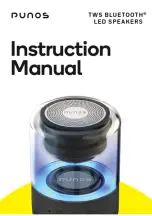
CHAPTER 3: AMPLIFICATION AND AUDIO
14
NOTE:
Most source devices are capable of
driving loads no smaller than 10 times their
output impedance.
NOTE:
Make sure that all cabling for looped
loudspeakers is wired correctly (Pin 1 to Pin 1,
Pin 2 to Pin 2, and so forth) to prevent the polarity
from being reversed. If one or more loudspeakers in a
system have reversed polarity, frequency response
and coverage can be significantly degraded.
Limit LEDs
The UPJunior’s low- and high-frequency drivers are pow-
ered by separate amplifier channels, each with their own
limiter. Limiting activity is indicated with the two yellow Limit
LEDs. The top LED indicates limiting for the high-frequency
channel and the bottom LED indicates limiting for the low-
frequency channel. When engaged, a channel’s limiter not
only protects the driver, but also prevents signal peaks from
causing excessive distortion in the amplifier’s channel,
thereby preserving headroom and maintaining smooth fre-
quency responses at high levels. When a channel’s level
returns to normal, below the limiter’s threshold, limiting
ceases.
The UPJunior performs within its acoustical specifications at
normal temperatures when the Limit LEDs are unlit, or if the
LEDs are lit for two seconds or less and then turn off for at
least one second. If an LED remains lit for longer than three
seconds, that channel enters hard limiting where:
■
Increases to the input level have no effect.
■
Distortion increases due to clipping and nonlinear driver
operation.
■
The driver is subjected to excessive heat and excursion,
which will compromise its life span and may eventually
lead to damage over time.
CAUTION:
The Limit LEDs indicate when a
safe, optimum level is exceeded. If a UPJunior
begins to limit before reaching the required SPL, con-
sider adding more loudspeakers to the system.
NOTE:
The UPJunior uses optical limiters that
add no noise and have no effect on the signal
when the limiters are not engaged and the Limit LEDs
are not lit.
On/Temp LED
When the UPJunior is initially powered on, its On/Temp LED
is green. The LED turns red when the temperature of the
UPJunior’s heatsink reaches 75° C (167° F), at which point
its fan switches to high speed. While the UPJunior will con-
tinue to operate normally when the On/Temp LED is red, this
is an indication that the unit is reaching its maximum dissi-
pation and a reduction in SPL is recommended.
TIP:
When the UPJunior is connected to an
RMS network, the RMS software provides addi-
tional feedback on the loudspeaker’s operating tem-
perature. For more information, see Chapter 7, “The
RMS Remote Monitoring System.”
Amplifier Cooling System
The UPJunior amplifier employs a combination of natural
convection and forced air in its cooling system. The ampli-
fier’s heatsink allows natural convection cooling from the air
flowing near its fins. A low-noise fan forces air to the fins,
ensuring low temperatures for the amplifier even when the
loudspeaker is used under high ambient temperatures,
tightly packed conditions, and at high continuous levels.
CAUTION:
The UPJunior’s heatsink can reach
temperatures of up to 75° C (167° F) during
normal operation. Use extreme caution when
approaching the rear of the loudspeaker.
CAUTION:
To keep the UPJunior from getting
too hot, allow for proper ventilation around the
loudspeaker, especially when it is operated in tightly
packed conditions.
Limit LEDs
High-frequency limiter LED
Low-frequency limiter LED
!
!
!
Summary of Contents for UPJunior UltraCompact VariO
Page 6: ...CONTENTS vi ...
Page 12: ...CHAPTER 2 POWER REQUIREMENTS 12 ...
Page 16: ...CHAPTER 3 AMPLIFICATION AND AUDIO 16 ...
Page 20: ...CHAPTER 4 ADDING SUBWOOFERS TO A UPJUNIOR SYSTEM 20 ...
Page 22: ...CHAPTER 5 THE VARIO HORN 22 ...
Page 30: ...CHAPTER 6 QUICKFLY RIGGING 30 ...
Page 36: ...APPENDIX A INSTALLING THE OPTIONAL RAIN HOODS 36 ...
Page 41: ...UPJUNIOR OPERATING INSTRUCTIONS 41 UPJunior Dimensions ...
Page 42: ...APPENDIX C UPJUNIOR SPECIFICATIONS 42 ...
Page 43: ......















































